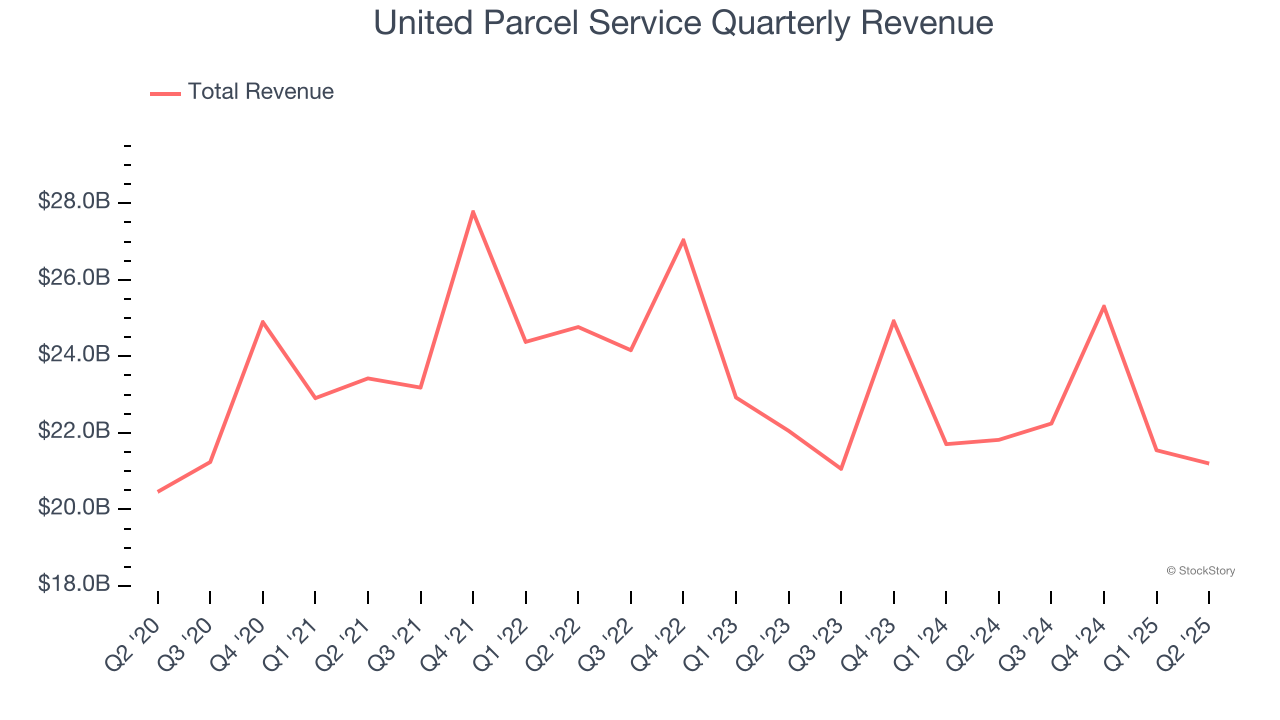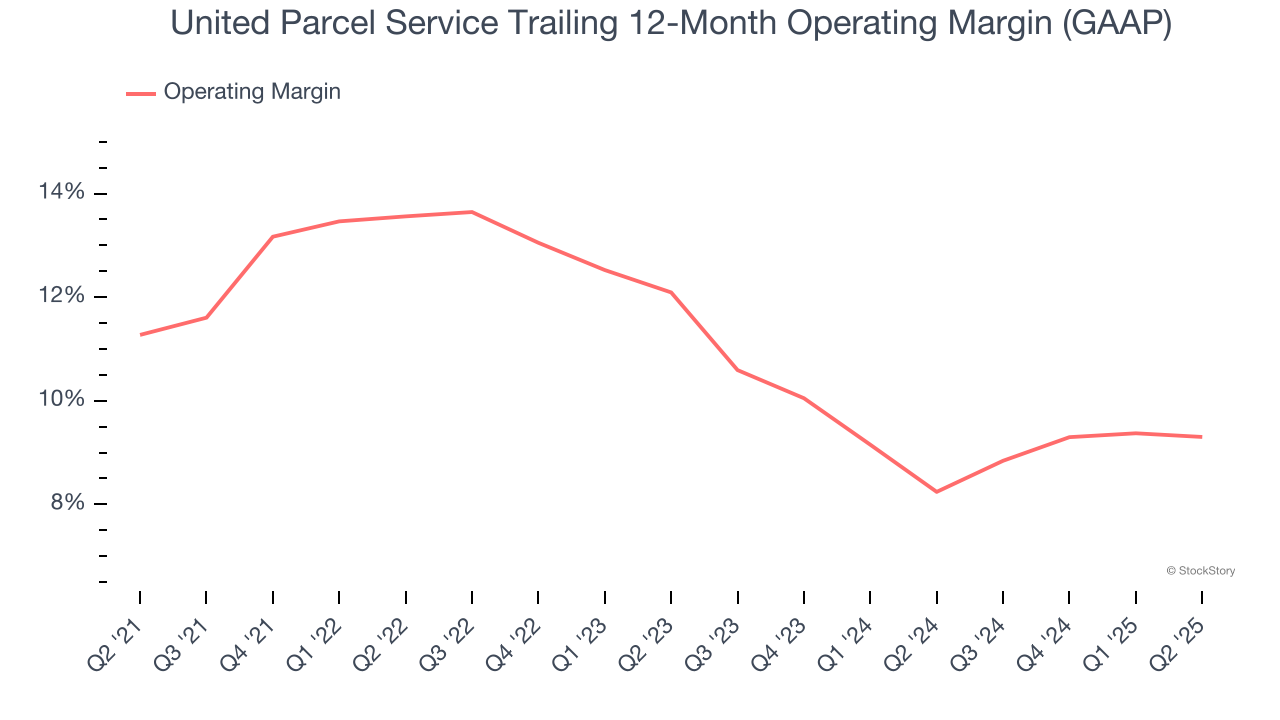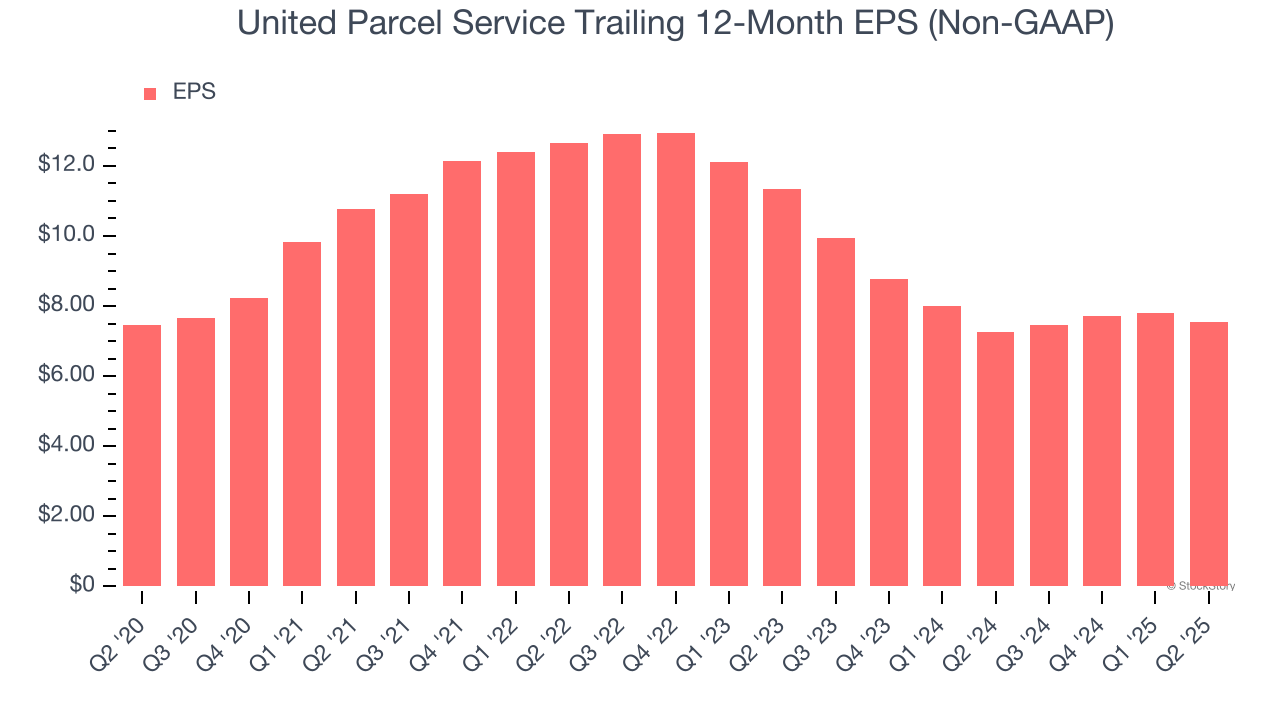
Parcel delivery company UPS (NYSE: UPS) reported Q2 CY2025 results beating Wall Street’s revenue expectations, but sales fell by 2.8% year on year to $21.2 billion. Its non-GAAP profit of $1.55 per share was 1% below analysts’ consensus estimates.
Is now the time to buy United Parcel Service? Find out by accessing our full research report, it’s free.
United Parcel Service (UPS) Q2 CY2025 Highlights:
- Revenue: $21.2 billion vs analyst estimates of $20.87 billion (2.8% year-on-year decline, 1.6% beat)
- Adjusted EPS: $1.55 vs analyst expectations of $1.57 (1% miss)
- UPS did not update its full-year outlook for a second straight quarter, citing ongoing macroeconomic uncertainty
- Operating Margin: 8.6%, in line with the same quarter last year
- Free Cash Flow Margin: 3.1%, down from 4.9% in the same quarter last year
- Market Capitalization: $86.02 billion
“I want to thank all UPSers for their dedication and hard work in what continues to be a dynamic and evolving trade environment,” said Carol Tomé, UPS chief executive officer.
Company Overview
Trademarking its recognizable UPS Brown color, UPS (NYSE: UPS) offers package delivery, supply chain management, and freight forwarding services.
Revenue Growth
A company’s long-term sales performance is one signal of its overall quality. Any business can have short-term success, but a top-tier one grows for years. Over the last five years, United Parcel Service grew its sales at a sluggish 3.1% compounded annual growth rate. This was below our standard for the industrials sector and is a rough starting point for our analysis.

Long-term growth is the most important, but within industrials, a half-decade historical view may miss new industry trends or demand cycles. United Parcel Service’s performance shows it grew in the past but relinquished its gains over the last two years, as its revenue fell by 3.1% annually. United Parcel Service isn’t alone in its struggles as the Air Freight and Logistics industry experienced a cyclical downturn, with many similar businesses observing lower sales at this time. 
This quarter, United Parcel Service’s revenue fell by 2.8% year on year to $21.2 billion but beat Wall Street’s estimates by 1.6%.
Looking ahead, sell-side analysts expect revenue to decline by 4.1% over the next 12 months, similar to its two-year rate. This projection doesn't excite us and implies its products and services will see some demand headwinds.
Unless you’ve been living under a rock, it should be obvious by now that generative AI is going to have a huge impact on how large corporations do business. While Nvidia and AMD are trading close to all-time highs, we prefer a lesser-known (but still profitable) stock benefiting from the rise of AI. Click here to access our free report one of our favorites growth stories.
Operating Margin
Operating margin is one of the best measures of profitability because it tells us how much money a company takes home after procuring and manufacturing its products, marketing and selling those products, and most importantly, keeping them relevant through research and development.
United Parcel Service has managed its cost base well over the last five years. It demonstrated solid profitability for an industrials business, producing an average operating margin of 11%. This result was particularly impressive because of its low gross margin, which is mostly a factor of what it sells and takes huge shifts to move meaningfully. Companies have more control over their operating margins, and it’s a show of well-managed operations if they’re high when gross margins are low.
Analyzing the trend in its profitability, United Parcel Service’s operating margin decreased by 2 percentage points over the last five years. Many Air Freight and Logistics companies also saw their margins fall (along with revenue, as mentioned above) because the cycle turned in the wrong direction. We hope United Parcel Service can emerge from this a stronger company, as the silver lining of a downturn is that market share can be won and efficiencies found.

This quarter, United Parcel Service generated an operating margin profit margin of 8.6%, in line with the same quarter last year. This indicates the company’s cost structure has recently been stable.
Earnings Per Share
Revenue trends explain a company’s historical growth, but the long-term change in earnings per share (EPS) points to the profitability of that growth – for example, a company could inflate its sales through excessive spending on advertising and promotions.
United Parcel Service’s flat EPS over the last five years was below its 3.1% annualized revenue growth. This tells us the company became less profitable on a per-share basis as it expanded due to non-fundamental factors such as interest expenses and taxes.

We can take a deeper look into United Parcel Service’s earnings to better understand the drivers of its performance. As we mentioned earlier, United Parcel Service’s operating margin was flat this quarter but declined by 2 percentage points over the last five years. This was the most relevant factor (aside from the revenue impact) behind its lower earnings; interest expenses and taxes can also affect EPS but don’t tell us as much about a company’s fundamentals.
Like with revenue, we analyze EPS over a more recent period because it can provide insight into an emerging theme or development for the business.
For United Parcel Service, its two-year annual EPS declines of 18.4% show its recent history was to blame for its underperformance over the last five years. These results were bad no matter how you slice the data.
In Q2, United Parcel Service reported EPS at $1.55, down from $1.79 in the same quarter last year. This print slightly missed analysts’ estimates. Over the next 12 months, Wall Street expects United Parcel Service’s full-year EPS of $7.55 to shrink by 2.7%.
Key Takeaways from United Parcel Service’s Q2 Results
It was encouraging to see United Parcel Service beat analysts’ revenue expectations this quarter. On the other hand, its EPS slightly missed. The company did not update its full-year outlook for a second straight quarter, citing ongoing macroeconomic uncertainty. The uncertainty coupled with falling year on year revenue and profits are likely weighing on the stock, and shares traded down 4.4% to $97.13 immediately after reporting.
Big picture, is United Parcel Service a buy here and now? When making that decision, it’s important to consider its valuation, business qualities, as well as what has happened in the latest quarter. We cover that in our actionable full research report which you can read here, it’s free.






